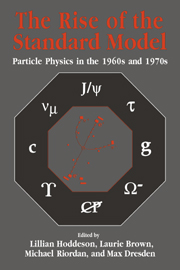Book contents
- Frontmatter
- Contents
- Contributors
- Editors' Acknowledgments
- Photographs of the Symposium
- Abbreviations and Acronyms
- Mathematical Notation
- Part One Introduction
- Part Two Quarks and Leptons
- Part Three Toward Gauge Theories
- 9 The Path to Renormalizability
- 10 Renormalization of Gauge Theories
- 11 Asymptotic Freedom and the Emergence of QCD
- 12 Quark Confinement
- 13 A View from the Island
- 14 On the Early Days of the Renormalization Group
- Part Four Accelerators, Detectors, and Laboratories
- Part Five Electroweak Unification
- Part Six The Discovery of Quarks and Gluons
- Part Seven Personal Overviews
- Index
12 - Quark Confinement
Published online by Cambridge University Press: 03 February 2010
- Frontmatter
- Contents
- Contributors
- Editors' Acknowledgments
- Photographs of the Symposium
- Abbreviations and Acronyms
- Mathematical Notation
- Part One Introduction
- Part Two Quarks and Leptons
- Part Three Toward Gauge Theories
- 9 The Path to Renormalizability
- 10 Renormalization of Gauge Theories
- 11 Asymptotic Freedom and the Emergence of QCD
- 12 Quark Confinement
- 13 A View from the Island
- 14 On the Early Days of the Renormalization Group
- Part Four Accelerators, Detectors, and Laboratories
- Part Five Electroweak Unification
- Part Six The Discovery of Quarks and Gluons
- Part Seven Personal Overviews
- Index
Summary
In this chapter I present a personal reminiscence of the development of our current ideas about quark confinement. I describe what I remember of my own involvement and that of the people who influenced me. If others remember it differently, I hope they will not be too angry.
By the end of the 1960s our empirical knowledge of hadrons consisted of a vast mountain of data about their spectrum, their low- and high-energy interactions, and their electromagnetic and weak properties. To some extent the story of the eventual interpretation in terms of QCD was like digging a tunnel through the mountain with crews of diggers starting independently at the two ends. At one end was the short-distance behavior of local currents and its interpretation in terms of freely moving quark-parton constituents. At the other end was the low-momentum-transfer Regge structure including a spectrum of highly excited rotational states, shrinking diffraction peaks, and multihadron final states of peripheral collisions, but no free quarks. Sometime in 1973 the two tunnel crews discovered that they had met and a complete picture of the strong interactions existed. Of course the two crews were not entirely unaware of each other. The Regge workers were beginning to organize the trajectories by quantum numbers suggested by the quark model. Eventually, the Regge picture culminated in 1968 with a set of scattering amplitudes based on the duality principle of R. Dolen, D. Horn, and C. Schmidt.
- Type
- Chapter
- Information
- The Rise of the Standard ModelA History of Particle Physics from 1964 to 1979, pp. 233 - 242Publisher: Cambridge University PressPrint publication year: 1997
- 1
- Cited by



